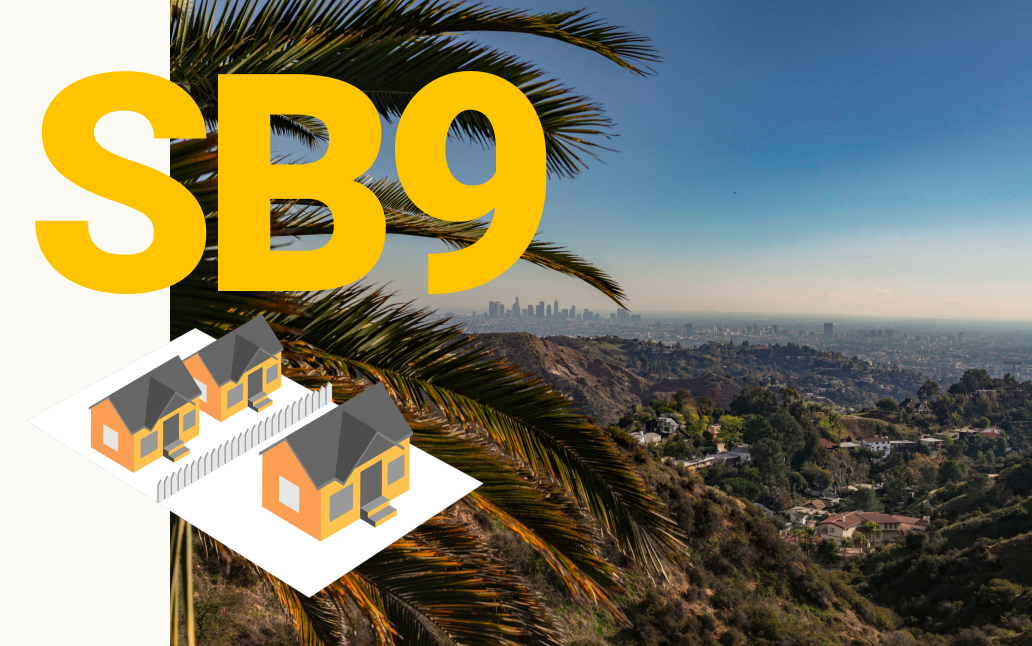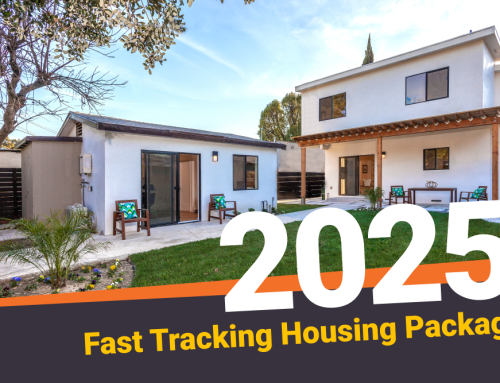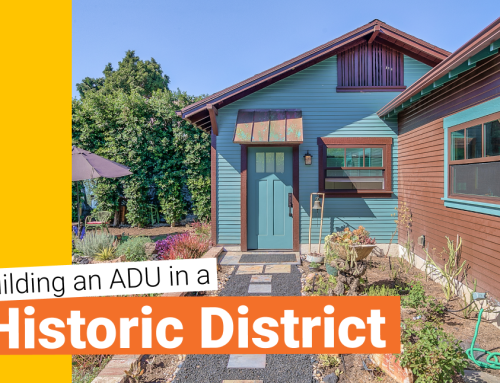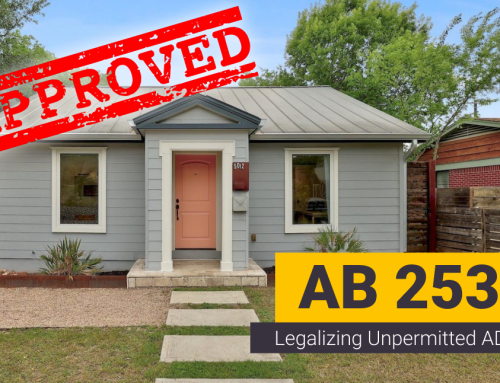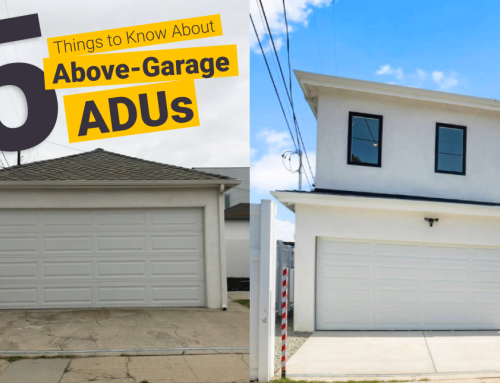Senate Bill 9 (SB9) made headlines in 2022 as it allowed California homeowners to split their single-family properties into two separate lots. Aimed at addressing housing shortages and fostering more sustainable urban growth, SB9 is poised to redefine property ownership and offer innovative housing solutions for Los Angeles residents. In this exploration of SB9, we navigate through the specific implications for Los Angeles, unravel the complexities, and walk you through the process to getting your property approved.
But first, let’s define what exactly this bill entails.
What is SB9?
California SB9 is a bill that allows for homeowners to split their properties into two separate properties and/or build a duplex on each.
There are two main components to the bill:
- Lot split provision
- Duplex provision
Both of these provisions can either be used individually or in conjunction with one another.
Lot Split Provision
The lot split provision of SB9 allows for single-family properties to be split into two lots. This is ideal for properties with large underutilized backyards.
Once split, the new resulting lot can either be sold as an empty parcel, or you can build a new dwelling on it, either a single-family home or a duplex. This leads us to our next provision.
Duplex Provision
The duplex provision of SB9 allows a single-family lot to now have two units. The new unit can either be attached or detached from the existing residence.
If you do the math, this means that if you apply for both of these provisions on your property, you could have four dwellings on your property. This is a big positive change for Los Angeles real estate. As such, the city is working to define and clarify the regulations surrounding these provisions to encourage homeowners to take the leap.
How to Get SB9 Approval in Los Angeles

Navigating SB9 lot splits and duplex provisions in Los Angeles successfully requires an understanding of the restrictions and opportunities made available to interested homeowners. Let’s define some of the most significant guidelines that will help streamline the process.
#1. Confirm property eligibility
Before starting the application process, make sure your property is eligible to be split. The regulations for lot-splits in Los Angeles are as follows:
- The property is within a single-family residence zone (R-1, R-A)
- The property is empty or the split will not result in more than two dwelling units per parcel.
- Lots must be at least 1,200 after splitting.
- The split ratio cannot be greater than 60/40. You cannot split a lot into one 1,200 sq. ft. lot and one 3,000 sq. ft. lot.
- The split can only be done once to a property.
- Owner occupancy on one of the lots is required for at least three years. An affidavit is required.
- The split cannot result in demolition of existing dwelling units that have been occupied/rented within the last three years.
If your plans and property adhere to all of the above, you can start looking at the application process!
#2. Contact a designer

If you only plan on splitting your property, you may be able to skip this step, however, having a designer help you with the lot-split application is never a bad idea. A good designer will have plenty of experience coordinating with the city and can potentially expedite the process.
For adding a duplex or a single-family residence, on the other hand, this step is a must. Make sure you are hiring a designer that is familiar with the SB9 application process in Los Angeles. Having a professional that knows the local regulations will ensure that your plans align with local zoning regulations and adhere to the nuances of SB9.
In your first meeting with your designer, they’ll want to review your property and discuss your ideas for the new dwelling unit. They’ll handle creating the entire permit set necessary for you to obtain the required permits.
#3. Prepare your application
Los Angeles requires all applicants to first register in EPIC-LA. This online portal will allow you to apply online and pay the required fees.
The first application required will be the DRP Base Application, which will give the planning department an idea of your plans.
From there, the following forms will also be asked of you:
- Owner Acknowledgement Form
- Pre-Existing Site Conditions and Occupant Income Certification
- Owner Occupancy Affidavit
- SB 9 Applicant Acknowledgement Form
#4: Subdivision review process
With everything submitted, including your permit set, documents, and fees, the application enters the subdivision review process.
The Interdepartmental Subdivision Team (IST) begins with an analysis of the tentative design and SB9 requirements and ministerial Tentative Map approval. Ministerial means that the review of the map is strictly objective. It should only involve quantifiable or fixed standards like height or setbacks of the proposed duplex design.
Once approved, the application moves to the Department of Public Works (DPW) for clearance on the final design and project requirements.
Finally, it enters the final Ministerial Site Plan Review where the architectural plans are reviewed for compliance with all Los Angeles requirements. They may require revisions to the plans, but this should be handled by your designer.
With everything approved, the DWP will issue your permits to begin construction.
Lets chat about your ADU! 888-461-3884
SB9 Waivers in Los Angeles

Photo from Winton Homes
Under SB9, applicants can ask for exceptions to certain rules related to zoning, how land is divided, and design reviews. These rules, known as “objective standards,” should not prevent the lot splits or the construction of duplexes, each with at least 800 square feet of floor space. For projects involving duplexes under SB9, requests for exceptions can be made after corrections are issued for the building permit application. For lot splits under SB9, waiver requests can be part of the application process with City Planning.
Examples of rules that might be waived include:
- Zoning standards like height limits, front yard setback, driveway width, and passage requirements.
- Subdivision standards like street frontage, minimum lot width, and access strip requirements based on the property’s zone.
- Design standards such as plane break requirements or rules about the materials and transparency, as specified by the Los Angeles Municipal Code or Specific Plans and Overlays.
The key to a successful SB9 project lies in thorough research, collaboration with experienced professionals, and staying informed about local regulations. While SB9 opens doors to innovative possibilities, it also underscores the importance of responsible and thoughtful development.
Stay Up to Date with Maxable
Stay at the forefront of California’s evolving property regulations, including the latest updates on SB9 and ADUs! Follow Maxable for timely insights, expert analysis, and crucial updates that empower you to navigate the ever-changing landscape of real estate development in Los Angeles and all over California. Don’t miss out on the latest trends and opportunities – stay informed, stay ahead. Subscribe to Maxable’s newsletter today for a future of informed decision-making in California’s dynamic real estate environment!
FAQs About SB9 in Los Angeles

What are the setback requirements for SB9 projects?
Setback requirements for new dwelling units under SB9 are subject to four foot side and rear setbacks. Front setbacks are defined by the property’s underlying zoning code.
Do I need to provide parking for new units under SB9?
One covered off-street parking space is required per unit on a property. However, if the property is located within half a mile walking distance from a high quality transit corridor or a public transit stop, parking is not required.
Can SB9 be used for adding an ADU?
In Los Angeles, if you are doing a lot-split AND adding a duplex, you cannot add an ADU to the property that has a duplex.
However, if you decide to just do the duplex provision without the lot split, you could add two detached ADUs to the property.

